Justin Nuyda (1944-2022) was a Filipino artist known for his passion for painting and butterflies. His archive includes previously unpublished photos of his relationships in the art scene. Ayni Nuyda, daughter of the late Justin Nuyda and founder of the Search Mindscape Foundation, describes her father’s ikigai as, “his love affair with the visual arts and the natural world.” “While he was battling with Stage IV kidney cancer, he looked at me and said, ‘I’ll go if I can no longer paint.’ He never feared death but he feared losing his sense of sight and losing the mobility of his hands.”
 According to Ayni Nuyda, her father was a deeply sentimental man and only kept paintings with sentimental value to him. This interaction painting by members of the Saturday Group Justin Nuyda’s most prized possessions. Photo by Patrick de Veyra
According to Ayni Nuyda, her father was a deeply sentimental man and only kept paintings with sentimental value to him. This interaction painting by members of the Saturday Group Justin Nuyda’s most prized possessions. Photo by Patrick de Veyra
Justin succumbed to Stage IV kidney cancer at the age of 77. This year would have marked his 80th birthday. For Ayni and members of the Nuyda family, honoring the life and legacy of a man deemed larger than life was both a thrilling and daunting challenge. Justin’s life and work transcended labels. He was an artist, scientist, and mixologist behind the iconic Weng Weng cocktail.
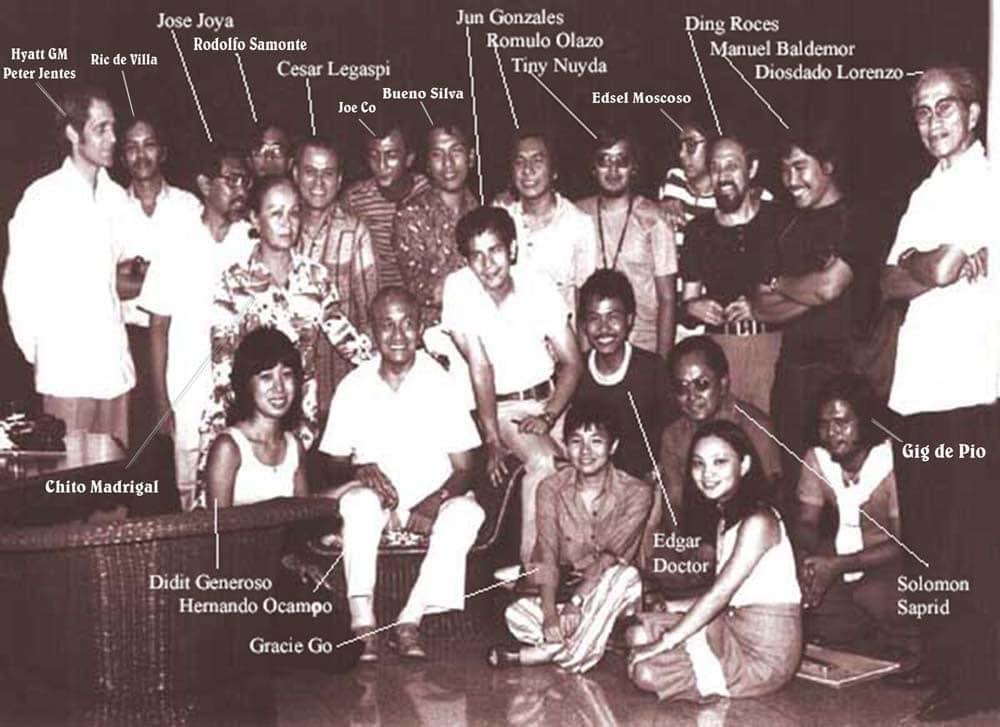 “The Saturday Group was an informal gathering not only of artists, but also of writers, musicians, filmmakers, dancers and even their children. While painting, they would have intellectual discussions, much like the European salons where artists, philosophers and writers would gather to discuss and debate ideas on the issues of their time,” shares curator Stephanie Frondoso
“The Saturday Group was an informal gathering not only of artists, but also of writers, musicians, filmmakers, dancers and even their children. While painting, they would have intellectual discussions, much like the European salons where artists, philosophers and writers would gather to discuss and debate ideas on the issues of their time,” shares curator Stephanie Frondoso
He was also the youngest among the founding members of The Saturday Group, a formidable group of Filipino visual artists that included National Artists Legaspi, Manansala, Luz, Ang Kiukok, BenCab, Joya, and more.
His polychromatic mindscapes revealed his rich inner world and also evoked the nuanced, ephemeral beauty of the butterfly wing. He called butterflies “winged jewels,” linking them to his art.
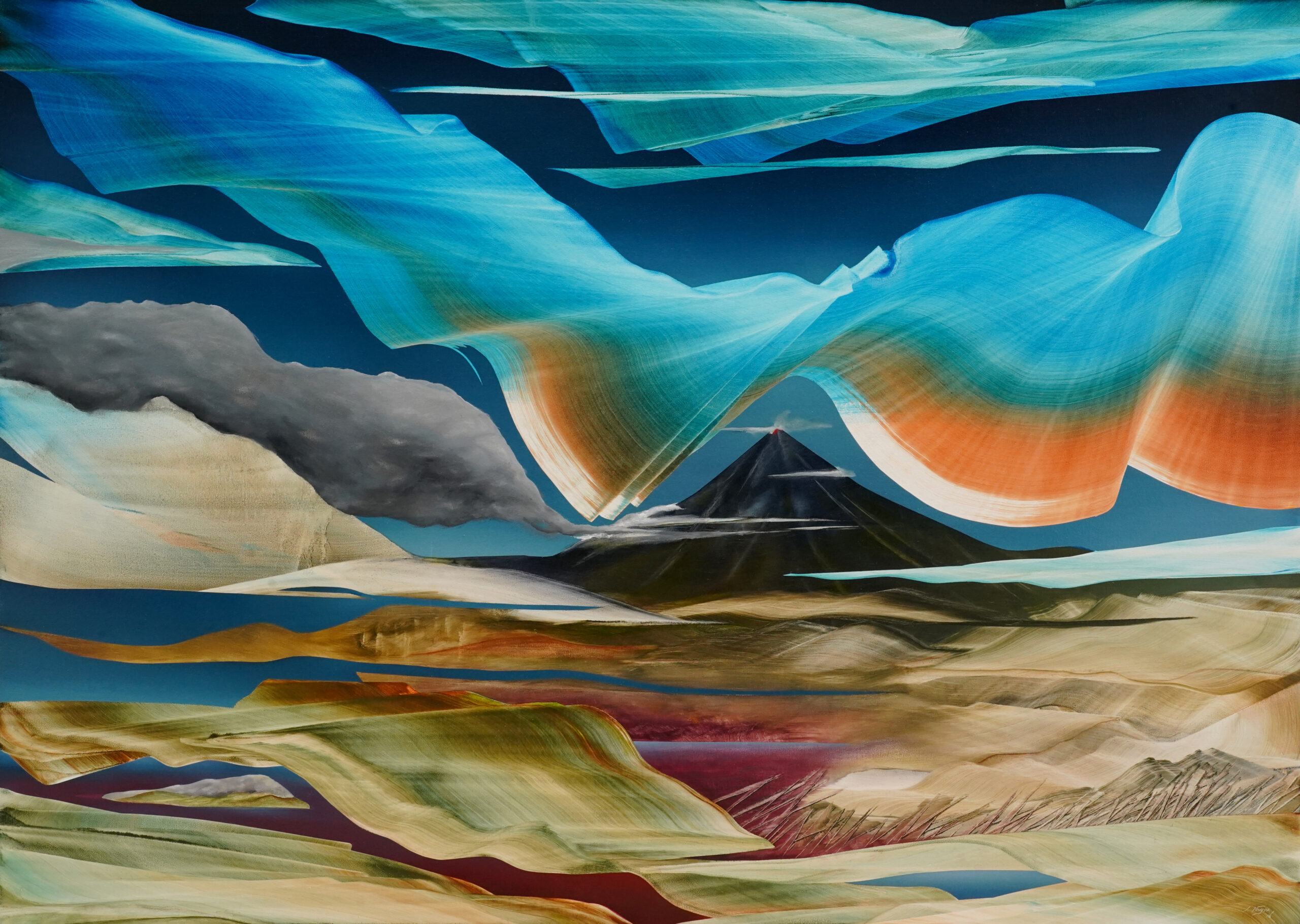 “People genuinely connecting to his works and resonating with his mindscapes made him truly happy,” shares Ayni Nuyda. Photo from the Justin Nuyda estate
“People genuinely connecting to his works and resonating with his mindscapes made him truly happy,” shares Ayni Nuyda. Photo from the Justin Nuyda estate
As a tribute to the life and legacy of the late Justin Nuyda on the occasion of his 80th birthday, the Justin Nuyda Estate collaborated with art curator Stephanie Frondoso and chefs Thirdy Dolatre and Kevin Navoa of Hapag.
The idea was to curate a multisensory experience that celebrated the many facets of Nuyda’s life. For Hapag’s Dolatre, the process of collaboration was not without challenges, as they dove into Bicolano cuisine all while staying true to Justin’s signature dishes under Hapag’s creative lens.
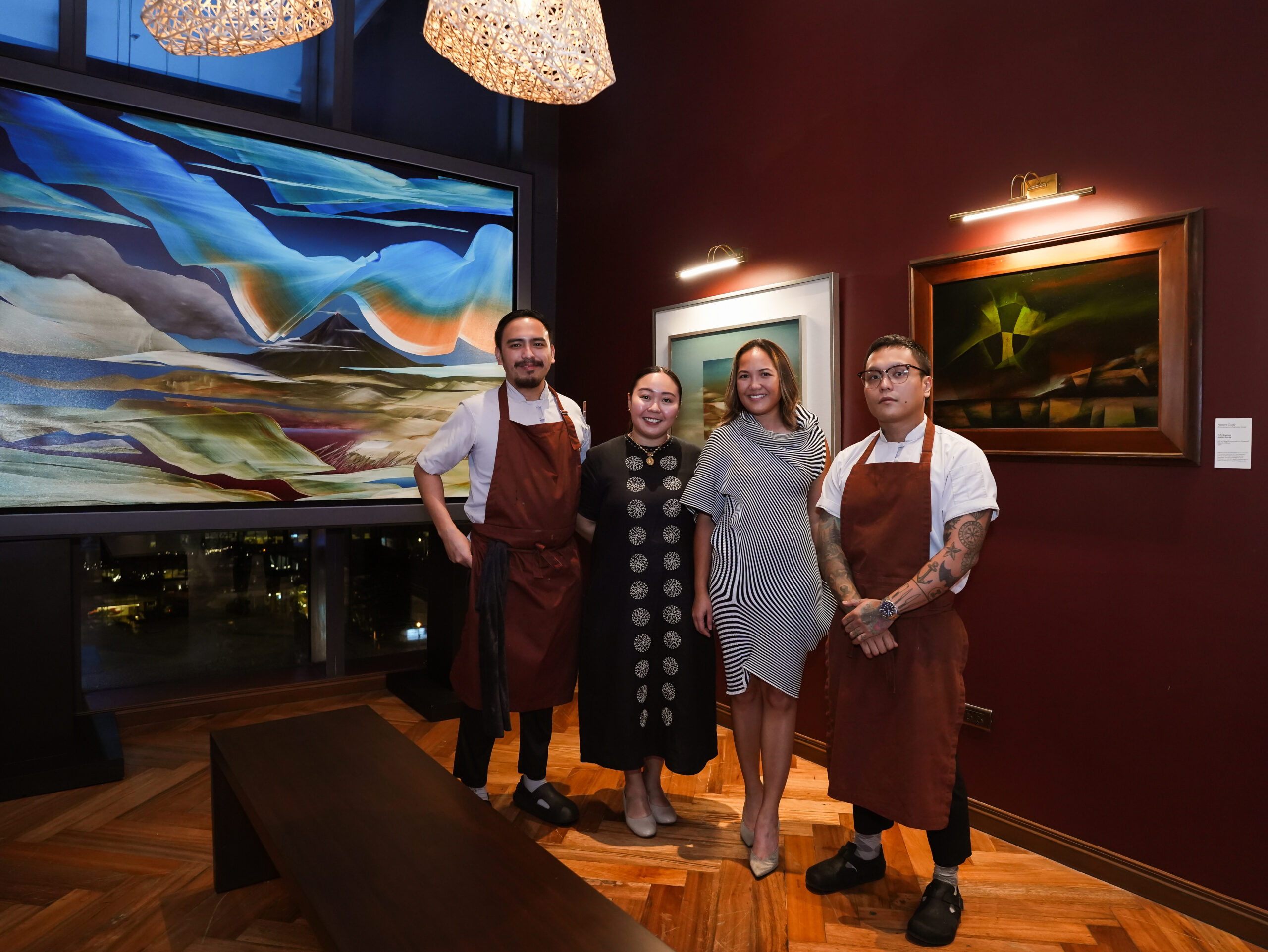 Ayni Nuyda with Hapag’s chef Kevin Navoa, chef Thirdy Dolatre, and sommelier Erin Recto. Photo from Search Mindscape Foundation
Ayni Nuyda with Hapag’s chef Kevin Navoa, chef Thirdy Dolatre, and sommelier Erin Recto. Photo from Search Mindscape Foundation
As for the archive of photographs held by the Nuyda estate, Frondoso highlights the rich collection of memorabilia, “He kept the beautifully designed posters for exhibits in the 1970s. He was also a photographer and kept a collection of slides. He documented many gatherings of The Saturday Group, shot his own self-portraits, and was captured by highly respected photographers like Wig Tysmans and Baron Patrick de Koenigswarter,” says Frondoso.
READ: Colin Dancel on photography, trust, and the ways an image can exist In this interview, Ayni and Frondoso discuss the life and legacy of the late artist as well as the multisensory exhibition and dinner at Hapag held in his honor.
Ayni, from your point of view as a daughter, who was Justin Nuyda? Ayni Nuyda (AN): My father Justin Nuyda was a man who had a strong sense of self and self-worth. Unlike how many artists are stereotypically portrayed as being antisocial or socially awkward, my father was great at navigating socially. He had a very good radar for identifying like-minded people. He loved having deep and meaningful conversations with people who are rich with ideas and creativity. As an artist and learner, he was a social butterfly. As a father, he was hands-on. He was the kind of father who was always around. We loved his cooking as he was a terrific cook. In fact, during the pandemic, I made sure that I got to inherit all his recipes.
 “Justin Nuyda: Origin Story” at Hapag. Photo from Search Mindscape Foundation
“Justin Nuyda: Origin Story” at Hapag. Photo from Search Mindscape Foundation
In “Justin Nuyda: Origin Story” at Hapag, an entire wall is filled with portraits of him by his seniors and contemporaries. These portraits provide us clues about his relationships within the Philippine art scene of his time. My father didn’t have an air of superiority or seniority when relating with younger, more inexperienced artists. He treated them as how his seniors HR Ocampo, Vicente Manansala, and Cesar Legaspi treated him—with much respect. He was just paying it forward to the many younger artists who eventually became his friends, too. This, for me, is the beauty of The Saturday Group.
Can you walk us through this collaboration between the Justin Nuyda estate and Hapag? AN: One of the things we wanted to do for my father’s posthumous 80th birthday celebration was to pay tribute to a man who wasn’t just an artist but also a scientist, and explore the relationships and connections that made his entire being. It’s the first time for Hapag to create a menu that incorporates the narrative and essence of an important figure in Philippine art history. As for the Justin Nuyda Estate, it is also our first time to have the biography of the late Justin Nuyda to be reimagined as food. Art curator Stephanie Frondoso went on a deep dive and presented my father’s legacy with simplicity and depth, without diluting the essence of his practice, while the chefs, cooks, and staff of Hapag were able to absorb the salient points of my father’s legacy.
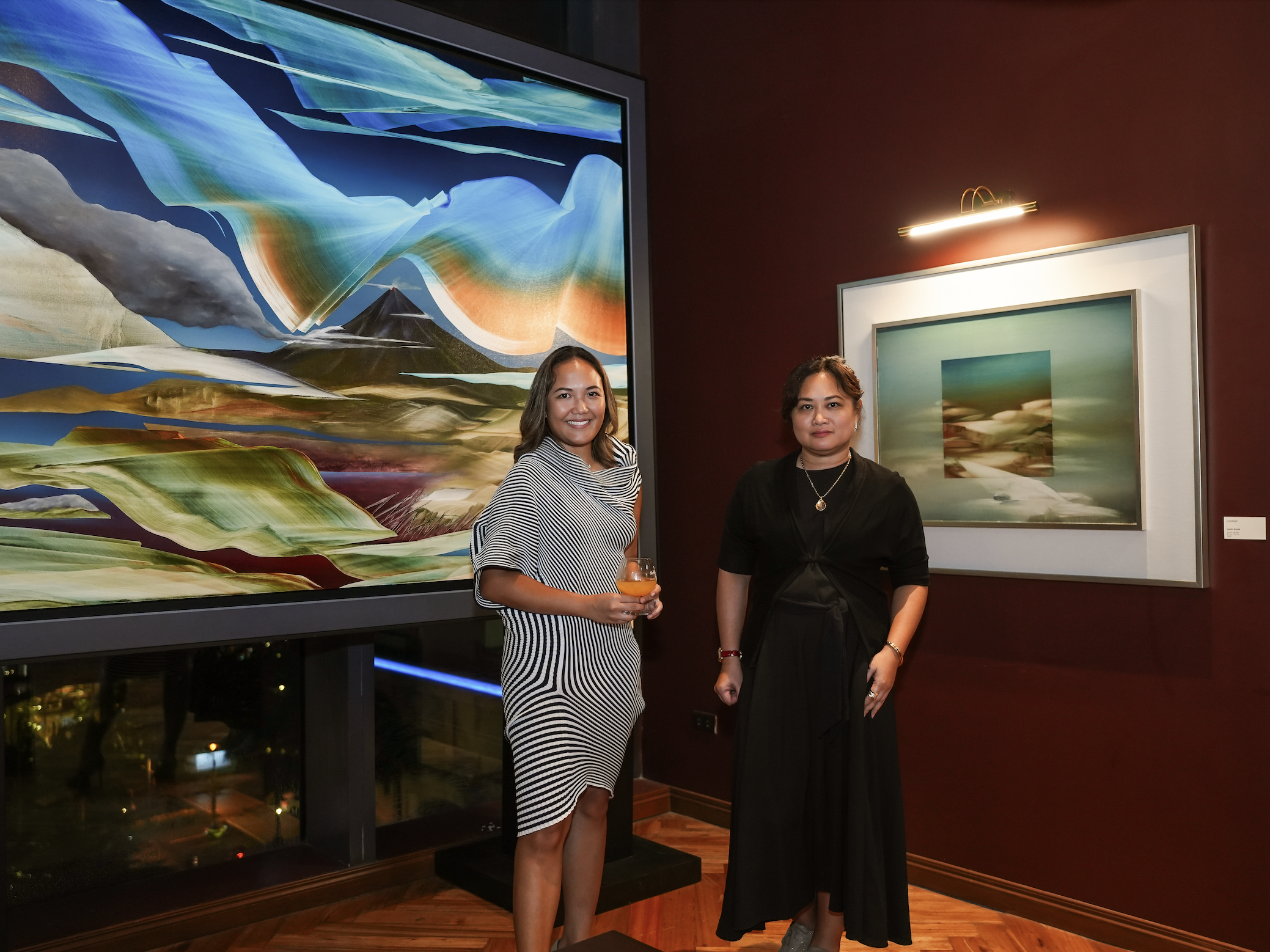 Ayni Nuyda and curator Stephanie Frondoso. Photo from Search Mindscape Foundation
Ayni Nuyda and curator Stephanie Frondoso. Photo from Search Mindscape Foundation
Stephanie Frondoso (SF): When Ayni approached me to help her, she hosted me for dinner at Hapag so that I would not only see the location but also experience their cuisine, both of which are crucial to informing my curatorial decisions. As the daughter of Justin Nuyda, she felt too close to our artist subject and needed a third-person perspective, especially in selecting from his prolific body of work and deciding on which artworks we should include in the show. Ayni also made it clear that she wanted to celebrate not only her father’s art but his entire life. His work was largely influenced by his friendships in The Saturday Group; he was the youngest member of its founders and the older artists took him under their fold. His practice as a lepidopterist or butterfly specialist also heavily impacted his art.
What is the central philosophy and curatorial framework behind Hapag’s Justin Nuyda-themed 10-course degustation? AN: The Bicolano adobo was very much a part of my late father’s DNA. I made sure that chefs John Kevin Navoa and Thirdy Dolatre of Hapag wouldn’t miss that particular detail about my father. I discussed his process but I also made sure that the chefs didn’t try my father’s recipe. I wanted them to have their own meaningful interpretation. They did an impeccable job.
 The Bicolano Adobo. Photo from Search Mindscape Foundation
The Bicolano Adobo. Photo from Search Mindscape Foundation
SF: In addition to being a great artist and lepidopterist, Nuyda was an excellent cook. Chefs are themselves artists; they respond to the world through research, experimentation, and creative execution. But cooking is their realm, and I could only provide ideas from the Metodolohiya menu that they could take off from while responding to Nuyda’s heritage recipes from Bicol. For example, Hapag makes an inadobo and was planning to attempt a recreation of Nuyda’s adobo sa asin. In my notes to them, I wrote, “Just as the inadobo method is commonly used throughout the Philippines but interpreted in varying recipes, Nuyda’s portraits are a variety of portrayals by his numerous artist friends. They are rendered as casual studies with less costly materials like pastels, charcoal, and pencil.” The chefs understood the comparison: Like adobo recipes, the portraits were variations on the same subject.
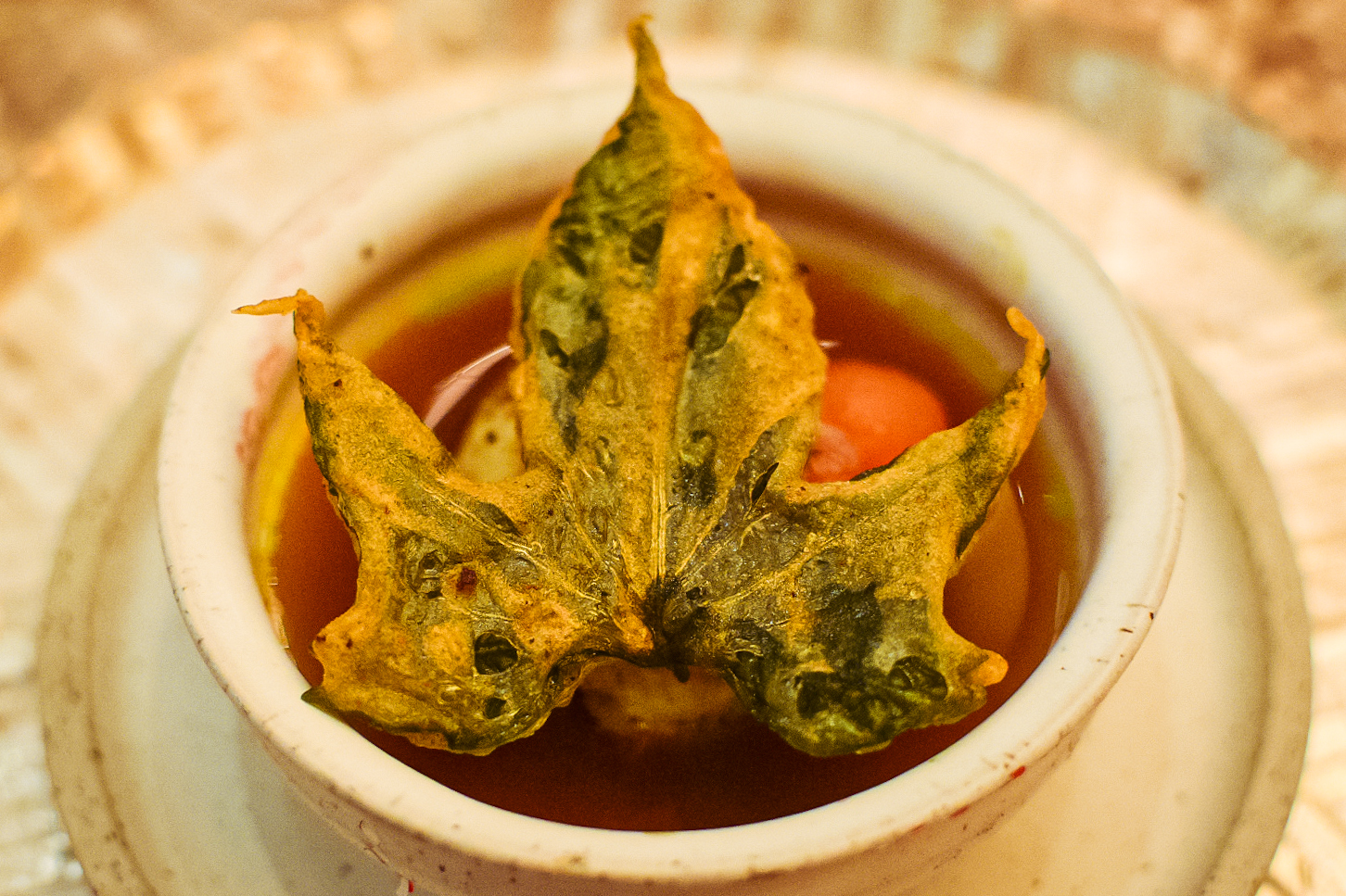 Hapag’s version of the Tinuktok soup. Photos by Patrick de Veyra
Hapag’s version of the Tinuktok soup. Photos by Patrick de Veyra
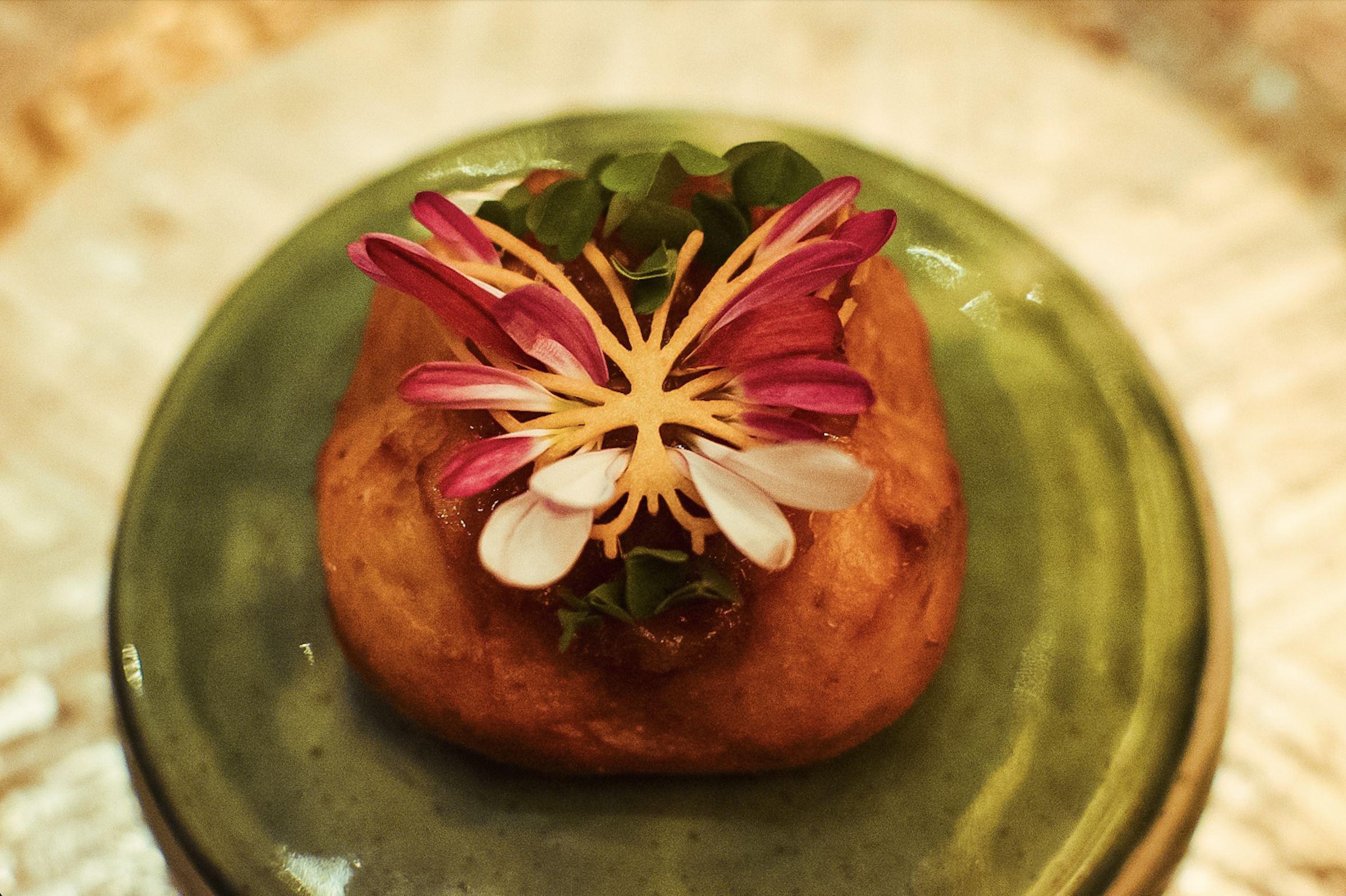 Chefs Thirdy and Nav’s creation garnished the bread with a butterfly design made of edible flowers
Chefs Thirdy and Nav’s creation garnished the bread with a butterfly design made of edible flowers
The chefs developed more recipes inspired by Bicol cuisine. Pinangat is a Bicolano version of laing, a spicy dish wrapped in gabi leaves. Hapag’s version was composed of mixed shrimp, tinapa, and coconut meat stewed in coconut milk and taro leaves. The tinuktok soup, which doesn’t use gata, has clear broth and ground fish rolled into balls. Hapag’s version was served with a refreshing tomato salsa. The chefs garnished the putok bread with a butterfly design made with edible flowers. Hapag’s use of edible flowers in many of their dishes is something I was able to relate to Nuyda’s butterflies, associated with flowers but also pollinators of food plants like fruits and vegetables.
READ: Anvil by Josh Boutwood, The Beef Bar, and Tealive drive demand and appetites
At the time Justin’s painting with HR Ocampo, now displayed at Hapag, was produced, Ocampo was one of the most established Filipino painters while Justin was just in his 20s. How special was this interaction painting for your late father? AN: The 1971 interaction painting “Nature Study” by HR Ocampo and Justin Nuyda was the very first recorded interaction painting of The Saturday Group. It has a sci-fi feel to it because of the prevalence of sci-fi films and literature in pop culture during that time. The last time this work was made available for public viewing was during the fifth death anniversary of HR Ocampo in 1984 at the Museum of Philippine Art. Forty years later, it’s available for public viewing once again at Hapag. Interestingly, this interaction painting is a testament to the culture of collaboration and mutual respect that the members of The Saturday Group had for one another regardless of age and stature.
 1971 interaction painting titled “Nature Study” by HR Ocampo and Justin Nuyda. Photo from the Justin Nuyda estate
1971 interaction painting titled “Nature Study” by HR Ocampo and Justin Nuyda. Photo from the Justin Nuyda estate
Stephanie, how has the Nuyda estate archive informed your curatorial practice? SF: This project reinforces my perspective that art does not exist in a vacuum. The artist is a total person and it is important to study his entire life instead of solely his art. A curator must consider the artist’s other interests, hobbies, favorite books and films, who his friends are and what their relationships might have been like.
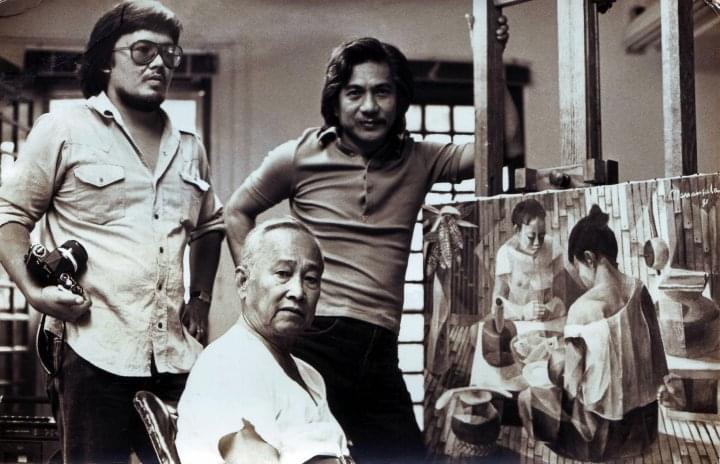 Justin Nuyda, Romulo Olazo, and Vicente Manansala. Photo from the Justin Nuyda estate
Justin Nuyda, Romulo Olazo, and Vicente Manansala. Photo from the Justin Nuyda estate
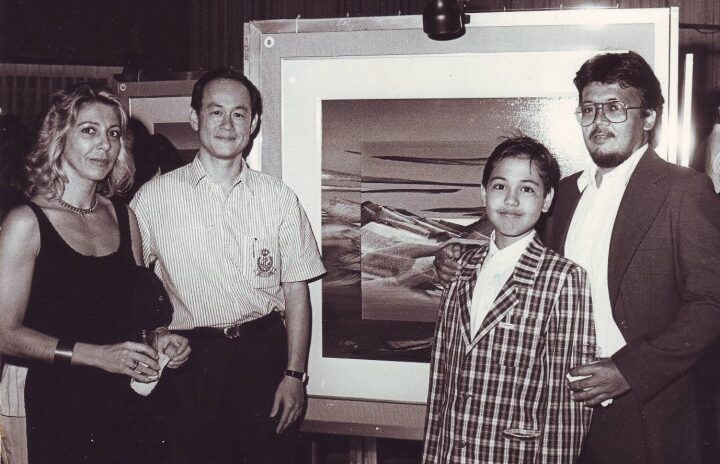 Silvana Diaz, Arturo Dy and guest of honor, Marco Ancelloti Diaz. Intercon, 1987
Silvana Diaz, Arturo Dy and guest of honor, Marco Ancelloti Diaz. Intercon, 1987
As a prime example, Nuyda was an illustrator of book covers by Nick Joaquin and F. Sionil Jose. Drawing was an important practice for his contemporaries. Many of them illustrated for journals or newspapers to earn income apart from selling art. Nuyda’s first exhibits were held at Solidaridad Galleries owned by F. Sionil Jose. His relationships with writers and journalists are key to understanding his body of work.
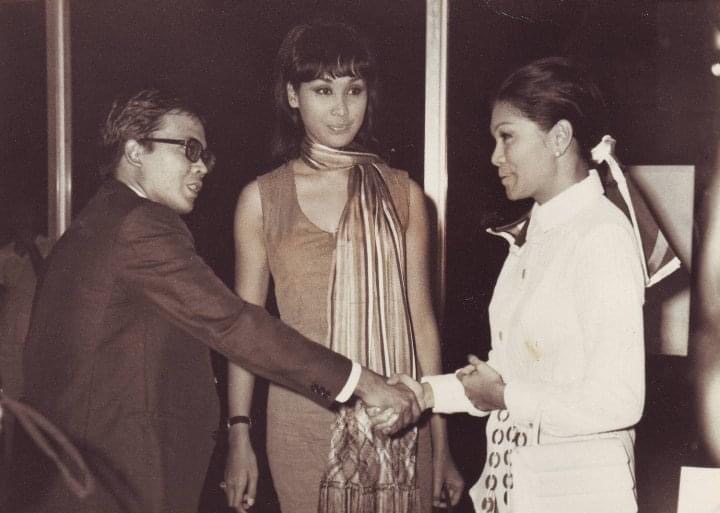 National Museum of Fine Arts Director Gemma Cruz was the guest of honor at Justin Nuyda’s Solidaridad Galleries exhibition circa 1970. Photo from the Justin Nuyda estate
National Museum of Fine Arts Director Gemma Cruz was the guest of honor at Justin Nuyda’s Solidaridad Galleries exhibition circa 1970. Photo from the Justin Nuyda estate
When you stand in front of a painting by Justin Nuyda, what do you see and feel, and are reminded of? AN: Apart from the colors of butterflies which a good number of art enthusiasts consider as the basis for his palette, my father’s journey across the Philippine archipelago trekking mountains from Luzon to Mindanao has shaped his visual and sensory experience of the natural world. His works are referred to as landscapes of the mind but his color harmonies and compositions had also been deeply inspired by the view from the peaks of the many mountains he had climbed.
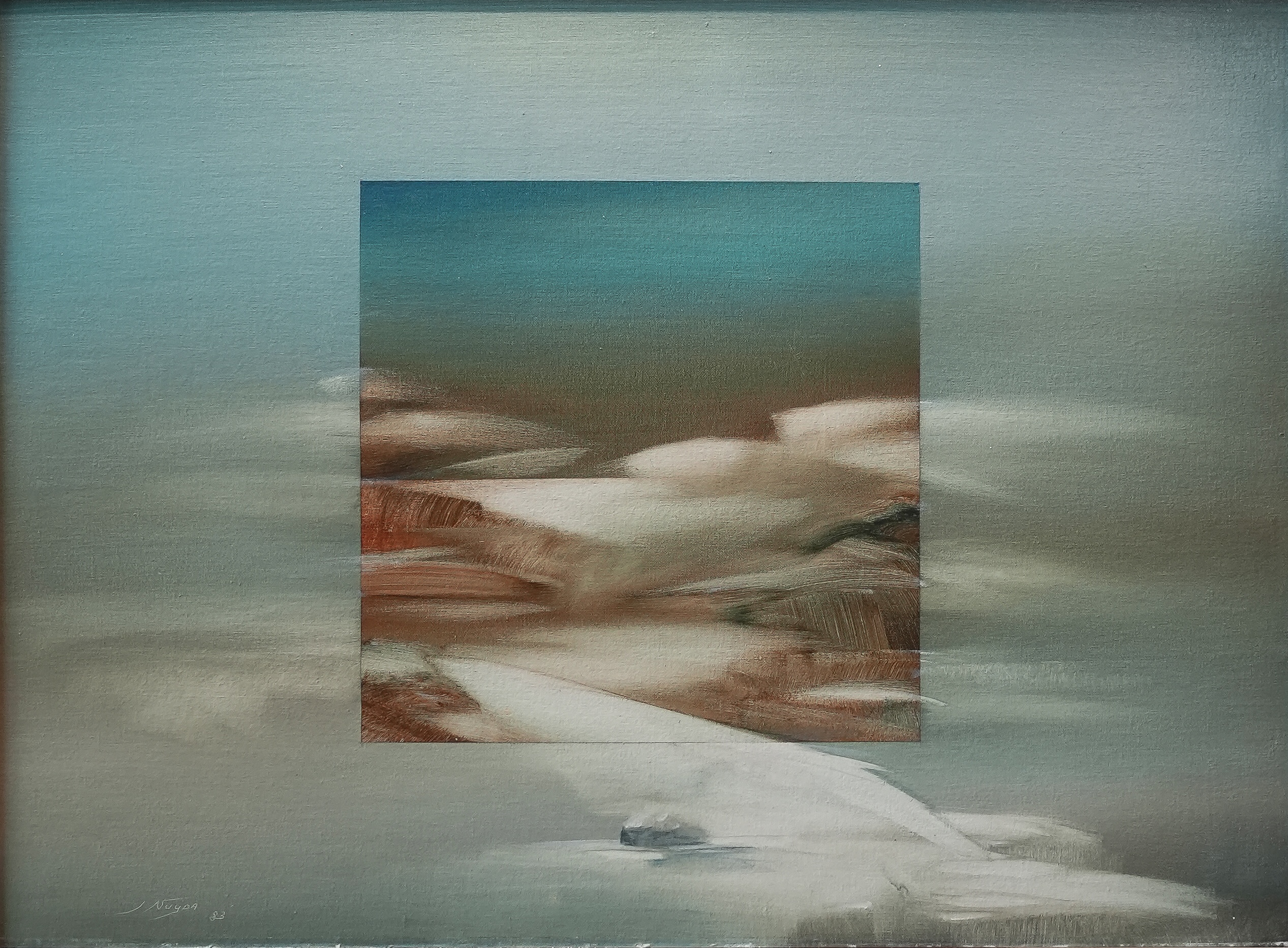 A 1983 painting part of Justin Nuyda’s Mindscape Series. Photo from the Justin Nuyda estate
A 1983 painting part of Justin Nuyda’s Mindscape Series. Photo from the Justin Nuyda estate
On those mountains, as a lepidopterist, he studied and collected specimens of what he referred to as “winged jewels.” Through his paintings, I vicariously join him in his adventures across our beautiful country and his journeys deep within his beautiful mind.
What are the most important lessons you have learned from your father’s example? AN: Staying humble, being grounded, and going back to one’s roots are perhaps the most important life principles he left behind. One truly noble thing about him was that neither hardship nor fame/success changed the core values of the artist in him. For my father, success and accolades paled in comparison to the richness of his journey as an artist. This is why I felt a profound connection with Hapag. Their ethos emphasizes celebrating our heritage—not merely the stereotypical or textbook definitions but a more poetic and personal understanding of what heritage truly means. On top of being an artist, lepidopterist, and cook, my father was also a mixologist. He concocted the famous Weng Weng cocktail at Hobbit House! Grateful that Martell’s mixologist Kia Opeda crafted a contemporary incarnation of my father’s signature cocktail.
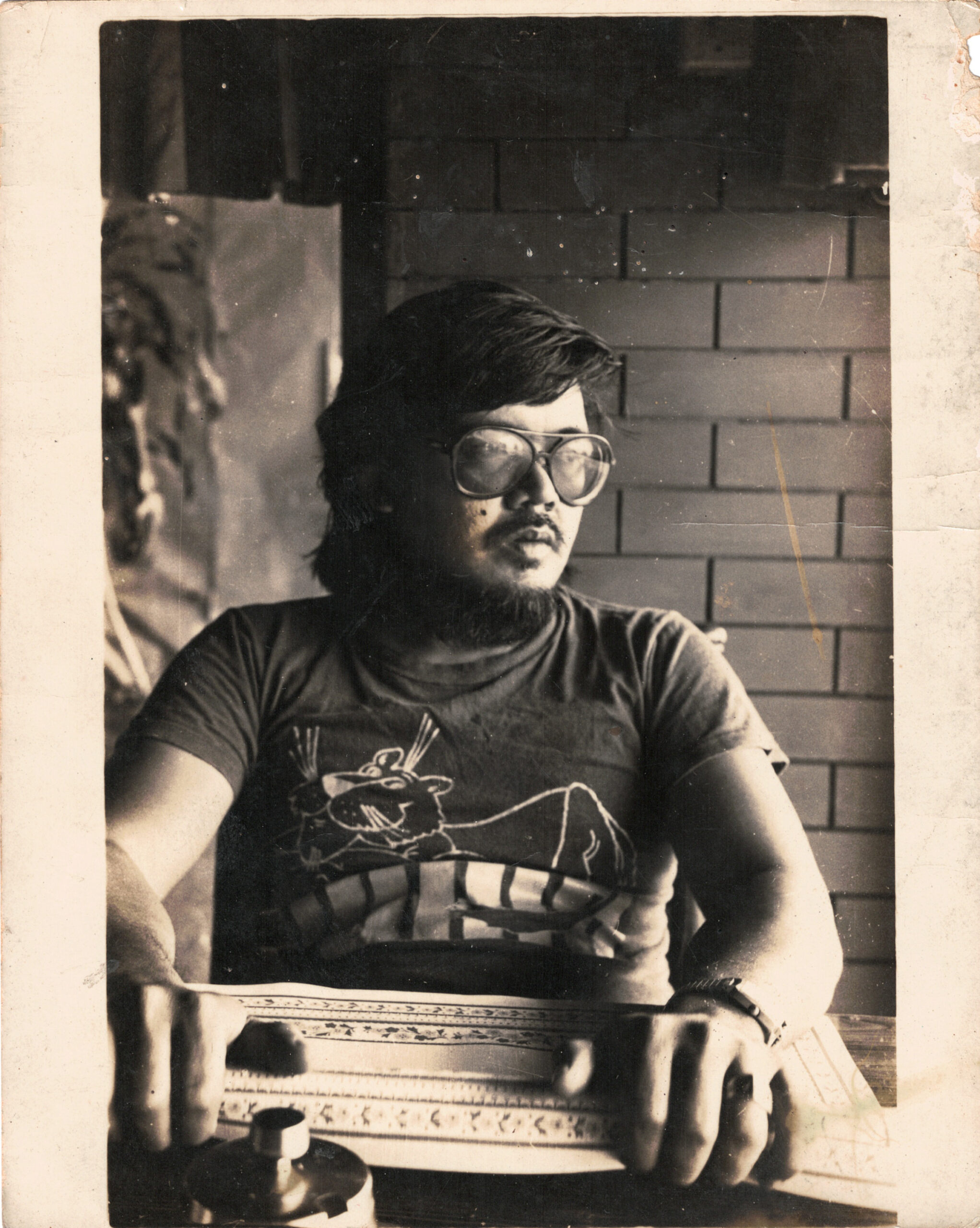 Artist Justin Nuyda. Photo from the Search Mindscape Foundation
Artist Justin Nuyda. Photo from the Search Mindscape Foundation
What would have made your father happy?
AN: People genuinely connecting to his art, people resonating with his mindscapes would have made him truly happy.
Why do you think your father chose to be an artist? AN: Art chose him.
READ: Artist Bjorn Calleja keeps it surrealhavefun888